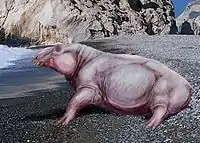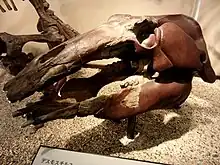索齒獸
索齒獸(學名:[1]),又名戴斯莫獸或束齒獸,是已滅絕的草食性哺乳動物,生存於 28.4 - 7.250 百萬年前[2]的漸新世晚期(恰特期)。
| 索齿兽属 化石时期: | |
|---|---|
 | |
| 科学分类 | |
| 界: | 动物界 Animalia |
| 门: | 脊索动物门 Chordata |
| 纲: | 哺乳纲 Mammalia |
| 目: | †索齒獸目 Desmostylia |
| 科: | †索齿兽科 Desmostylidae |
| 属: | †索齿兽属 Desmostylus Marsh, 1888 |
| 種 | |
| |
| 異名 | |
| |
描述

索齒獸像河馬,長約1.8(6英尺)及重200(440英磅)。牠有短的尾巴及強壯的四肢,肢上有四蹄。牠們的顎部較長,有向前的獠牙,是較長的犬齒及門齒[3]。索齒獸可能是完全水棲的,最早被認為生活在沿岸水深少於 30 公尺深的淺水區[4];不過近年來針對索齒獸化石同位素的分析研究顯示,牠們其實多半棲息於淡水或河口流域,以水草為食[5]。
索齒獸具有較低的骨質密度,這代表牠們可能是很活躍的水生生物,會在水面與水中游動尋找食物;這與其他索齒獸目的物種有很大的區別,其他索齒獸目的物種多半僅能進行緩慢的游泳或是在海床上行走[6]。
物種
目前索齒獸屬正式成立的物種共有 3 種:D. hesperus(異名與無效名:D. watasei、D. cymatias、D. californicus、D. mirabilis、D. minor、Desmostylella typica[2])、D. coalingensis(異名:Vanderhoofius coalingensis[7][8])與 D. japonicus。
Marsh 1888根據在美國加利福尼亞州費利蒙地區(座標:37.6°N 121.9°W、古座標:36.8°N 117.6°W)[9]所找到的部分牙齒化石將模式種命名為 D. hesperus。馬什爵士認為這個樣本屬於海牛目,並認為屬於 Metaxytherium屬(已絕種的儒艮近親)或是 Halicore屬(儒艮的過時名)[10]。
在這之後許多索齒獸的新物種根據牙齒的特徵差異而被發表。不過在這之後都被認為僅是 D. hesperus 的異名,因為同種之間的牙齒比起不同物種間本身就能具有很大的牙齒型態差異[11]。
D. japonicus 由 Yoshiwara & Iwasakai 1902 根據完整保存的部分顱骨進行發表並由 Tokunaga & Iwasaki 1914 進行命名,由於顱骨型態的差異而被確立為一新種[11]。
參考文獻
| 维基共享资源上的相关多媒体资源:索齒獸 |
- "Bound pillar", from Greek (desmos), bond, and (stulos), pillar, referring to the shape of the molars.
- . Paleobiology Database.. Retrieved March 2013.
- Palmer 1999,第228頁
- Kumiko Matsui; Katsuo Sashida; Sachiko Agematsu; Naoki Kohno (2017). "Habitat preferences of the enigmatic Miocene tethythere Desmostylus and Paleoparadoxia (Desmostylia; Mammalia) inferred from the depositional depth of fossil occurrences in the Northwestern Pacific realm". Palaeogeography, Palaeoclimatology, Palaeoecology. 471: 254–265. doi:10.1016/j.palaeo.2017.02.005.
- Clementz, Hoppe & Koch 2003
- Hayashi, S.; Houssaye, A.; Nakajima, Y.; Chiba, K.; Ando, T.; Sawamura, H.; Inuzuka, N.; Kaneko, N.; Osaki, T. . PLoS ONE. 2013, 8 (4): e59146. OCLC 837402105. PMC 3615000
 . PMID 23565143. doi:10.1371/journal.pone.0059146.
. PMID 23565143. doi:10.1371/journal.pone.0059146. - Tomida & Ohta 2007,第60頁
- Inuzuka, Domning & Ray 1984
- . Fossilworks. [December 2013]. (原始内容存档于2016-03-04).
- Marsh 1888,第96頁
- Uno & Kimura 2004,第1頁
- Barry Cox, Colin Harrison, R.J.G. Savage, and Brian Gardiner. (1999): The Simon & Schuster Encyclopedia of Dinosaurs and Prehistoric Creatures: A Visual Who's Who of Prehistoric Life. Simon & Schuster.
- Clementz, Mark T.; Hoppe, Kathryn A.; Koch, Paul L. . Paleobiology. 2003, 29 (4): 506–519. OCLC 211272891. doi:10.1666/0094-8373(2003)029<0506:APPTHA>2.0.CO;2.
- Inuzuka, Norihisa; Domning, Daryl P.; Ray, Clayton E. . Island Arc. 1984, 3 (4): 522–537. doi:10.1111/j.1440-1738.1994.tb00131.x.
- Marsh, O. C. . American Journal of Science. 1888, 25 (8): 94–96 [December 2013]. OCLC 79838746. 简明摘要 (December 2013).
- Palmer, Douglas. . London: Marshall Editions. 1999. ISBN 1-84028-152-9. OCLC 313633743.
- Reinhart, Roy Herbert. . University of California Publications in Geological Sciences. 1959, 36 (1): 1–146. OCLC 3474601.
- Tokunaga, S.; Iwasaki, C. (PDF). 1914 [December 2013].
- Tomida, Yukimitsu; Ohta, Toshikazu. (PDF). Memoir of the Fukui Prefectural Dinosaur Museum. 2007, 6: 57–61 [December 2013].
- Uno, Hikaru; Kimura, Masaichi. (PDF). Paleontological Research. 2004, 8 (1): 1–10 [December 2013]. doi:10.2517/prpsj.8.1.
- Yoshiwara, S.; Iwasaki, J. (PDF). Journal of the College of Science, Imperial University, Tokyo, Japan. 1902, 16 [December 2013].
